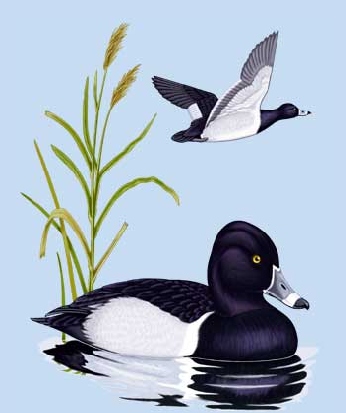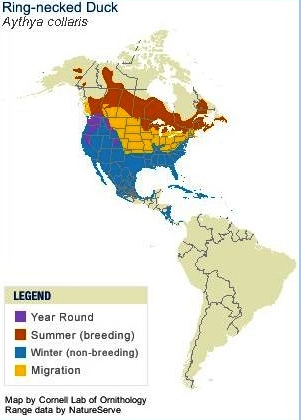|

Medium-sized
diving duck.
Black upperparts, weakly tufted, purple-black head. Neck, upper breast,
tail are black, lower breast and belly are white, sides are pale gray.
Cinnamon collar is hard to see in the field. Dark wings have black-tipped
gray flight feathers visible in flight. Blue-gray bill, white ring, black
tip.
The male Ring-necked Duck has black upperparts and a weakly tufted, glossy
purple-black head. Neck, upper breast, and tail are black, lower breast
and belly are white, sides are pale gray. Cinnamon collar is hard to see
in the field.

|
RING-NECKED
DUCK
Aythya collaris
ANSERIFORMES
Geese and Ducks (Anatidae)
Range and Habitat
Ring-necked Duck: Breeds from Alaska, Manitoba, and Newfoundland south
to California, Arizona, the Great Lakes, and Maine. Spends winters from
Washington south along the Pacific coast, east through the southwest
and the Gulf Coast states and north to New England. Found on wooded
lakes, ponds, and rivers; seldom seen on saltwater except in the southern
states.
SOUND: "deeeeer"
The Ring-necked Duck was first described in 1809 by Edward Donovan,
an Anglo Irish writer and amateur zoologist.
This species might better be called the "Ring-billed Duck,"
for its chestnut neck ring is usually seen only at close range, while
the white ring on the bill can be a prominent field mark.
Because it never gathers in large flocks it has not been hunted extensively
like some of its relatives. A fast flier, it undertakes longer migrations
than most other diving ducks.
A group of ducks has many collective nouns, including a "brace",
"flush", "paddling", "raft", and "team"
of ducks.
The Ring-necked Duck prefers to breed in lakes and ponds surrounded
by woodlands in the northern United States and Canada. In winter months,
this species will typically fly south to southern North America, searching
for lakes, ponds, rivers or bays. This species may also occasionally
migrate to western Europe, Central America and Costa Rica. This bird
dives for its food, and typical diets consist of plants, mollusks, insects
and small fish. Nests are built in a bowl shape and located in dry land
near open bodies of water. The conservation rating for the Ring-necked
Duck is Least Concern.
|